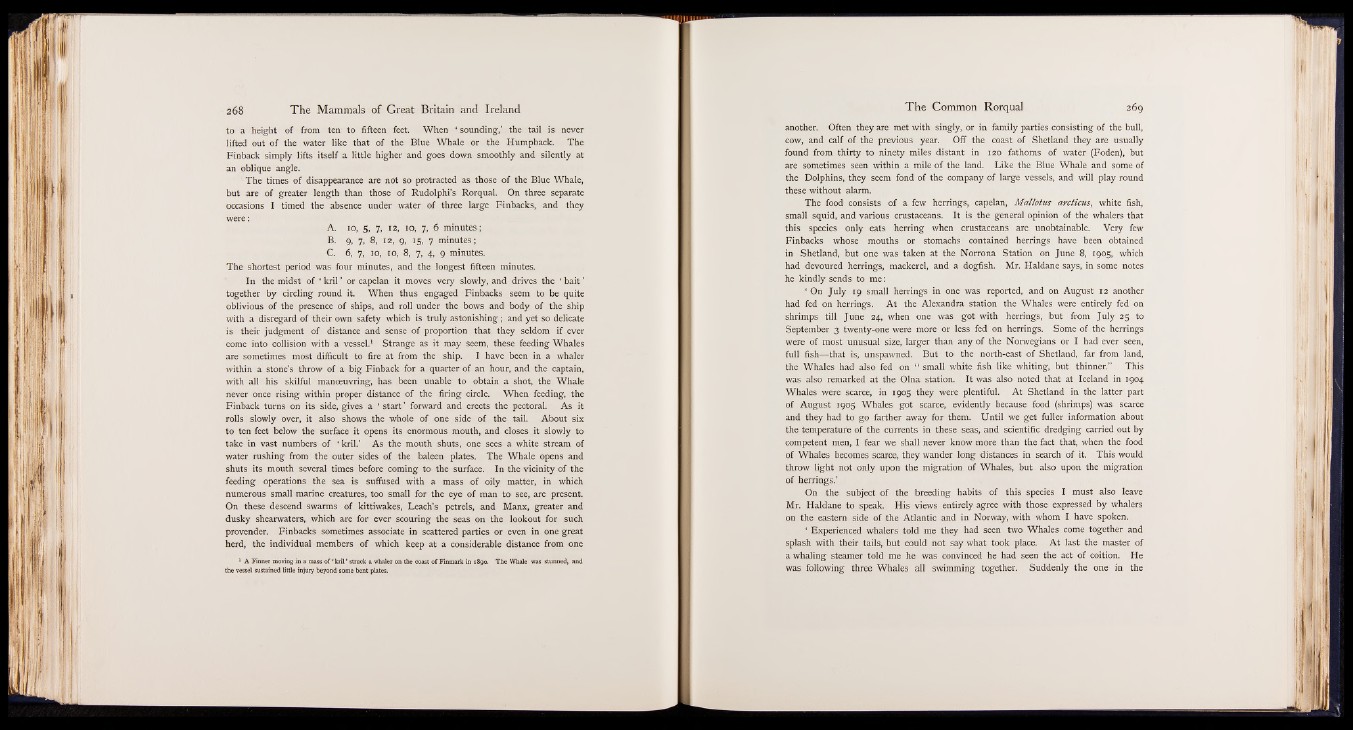
to a height of from ten to fifteen feet. When ‘ sounding/ the tail is never
lifted out of the water like that of the Blue Whale or the Humpback. The
Finback simply lifts itself a little higher and goes down smoothly and silently at
an oblique angle.
The times of disappearance are not so protracted as those of the Blue Whale,
but are of greater length than those of Rudolphi’s Rorqual. On three separate
occasions I timed the absence under water of three large Finbacks, and they
were:
A. io, 5, 7, 12, io, 7, 6 minutes;
B. 9, 7, 8, 12, 9, 15, 7 minutes;
C. 6, 7, 10, 10, 8, 7, 4, 9 minutes.
The shortest period was four minutes, and the longest fifteen minutes.
In the midst of ‘ kril ’ or capelan it moves very slowly, and drives the ‘ bait ’
together by circling round it. When thus engaged Finbacks seem to be quite
oblivious of the presence of ships, and roll under the bows and body of the ship
with a disregard of their own safety which is truly astonishing; and yet so delicate
is their judgment of distance and sense of proportion that they seldom if ever
come into collision with a vessel.1 Strange as it may seem, these feeding Whales
are sometimes most difficult to fire at from the ship. I have been in a whaler
within a stone’s throw of a big Finback for a quarter of an hour, and the captain,
with all his skilful manoeuvring, has been unable to obtain a shot, the Whale
never once rising within proper distance of the firing circle. When feeding, the
Finback turns on its side, gives a ‘ start ’ forward and erects the pectoral. As it
rolls slowly over, it also shows the whole of one side of the tail. About six
to ten feet below the surface it opens its enormous mouth, and closes it slowly to
take in vast numbers of ‘ kril.’ As the mouth shuts, one sees a white stream of
water rushing from the outer sides of the baleen plates. The Whale opens and
shuts its mouth several times before coming to the surface. In the vicinity of the
feeding operations the sea is suffused with a mass of oily matter, in which
numerous small marine creatures, too small for the eye of man to see, are present.
On these descend swarms of kittiwakes, Leach’s petrels, and Manx, greater and
dusky shearwaters, which are for ever scouring the seas on the lookout for such
provender. Finbacks sometimes associate in scattered parties or even in one great
herd, the individual members of which keep at a considerable distance from one
1 A Finner moving in a mass of ‘ kril’ struck a whaler on the coast of Finmark in 1890. The Whale was stunned, and
the vessel sustained little injury beyond some bent plates.
another. Often they are met with singly, or in family parties consisting of the bull,
cow, and calf of the previous year. Off the coast of Shetland they are usually
found from thirty to ninety miles distant in 120 fathoms of water (Foden), but
are sometimes seen within a mile of the land. Like the Blue Whale and some of
the Dolphins, they seem fond of the company of large vessels, and will play round
these without alarm.
The food consists of a few herrings, capelan, Mallotus arcticus, white fish,
small squid, and various crustaceans. It is the general opinion of the whalers that
this species only eats herring when crustaceans are unobtainable. Very few
Finbacks whose mouths or stomachs contained herrings have been obtained
in Shetland, but one was taken at the Norrona Station on June 8, 1905, which
had devoured herrings, mackerel, and a dogfish. Mr. Haldane says, in some notes
he kindly sends to me:
‘ On July 19 small herrings in one was reported, and on August 12 another
had fed on herrings. At the Alexandra station the Whales were entirely fed on
shrimps till June 24, when one was got with herrings, but from July 25 to
September 3 twenty-one were more or less fed on herrings. Some of the herrings
were of most unusual size, larger than any of the Norwegians or I had ever seen,
full fish— that is, unspawned. But to the north-east of Shetland, far from land,
the Whales had also fed on “ small white fish like whiting, but thinner.” This
was also remarked at the Olna station. It was also noted that at Iceland in 1904
Whales were scarce, in 1905 they were plentiful. At Shetland in the latter part
of August 1905 Whales got scarce, evidently because food (shrimps) was scarce
and they had to go farther away for them. Until we get fuller information about
the temperature of the currents in these seas, and scientific dredging carried out by
competent men, I fear we shall never know more than the fact that, when the food
of Whales becomes scarce, they wander long distances in search of it. This would
throw light not only upon the migration of Whales, but also upon the migration
of herrings.’
On the subject of the breeding habits of this species I must also leave
Mr. Haldane to speak. His views entirely agree with those expressed by whalers
on the eastern side of the Atlantic and in Norway, with whom I have spoken.
‘ Experienced whalers told me they had seen two Whales come together and
splash with their tails, but could not say what took place. At last the master of
a whaling steamer told me he was convinced he had seen the act of coition. He
was following three Whales all swimming together. Suddenly the one in the